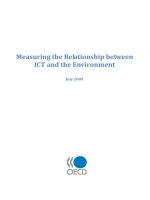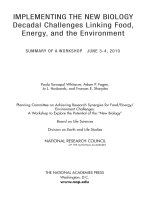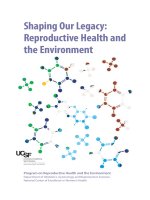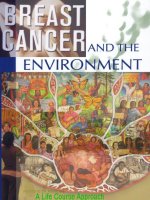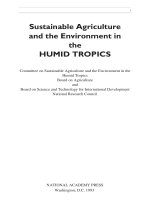Community Culture and the Environment pptx
Bạn đang xem bản rút gọn của tài liệu. Xem và tải ngay bản đầy đủ của tài liệu tại đây (10.01 MB, 293 trang )
Community Culture
and the Environment
A Guide to Understanding
a Sense of Place
DISCLAIMER
The Environmental Protection Agency (EPA) has compiled this
technical document of tools and methods for understanding the
human dimension of environmental protection. It is designed to
provide leaders in the environmental field a means for better
understanding community values and processes as they relate to
environmental issues, thus resulting in more effective
partnerships and approaches to solving environmental problems.
The tools are intended to assist communities in meeting or
exceeding current environmental protection standards. Mention
of organizations or products in this resource book does not
constitute an endorsement by EPA but is intended to provide
information, resources, or assistance the users may then evaluate
in terms of their own needs.
Community Culture and the Environment: A Guide to Understanding a Sense of Place i
ii Community Culture and the Environment: A Guide to Understanding a Sense of Place
ACKNOWLEDGMENTS
This Guide was prepared by EPA’s former Office of Policy and
the Office of Water with support from EPA contracts
68-W5-0054 and 8W-2690-NASA, and numerous social
scientists and environmental professionals.
For additional copies of this Guide, call the National Center
for Environmental Publications and Information at (513)
489-8190, (800) 490-9198, or by mail to NCEPI, U.S. EPA
Publication Clearinghouse, P.O. Box 42419, Cincinnati, OH
45242, or by e-mail to
If you want to cite the Guide, please refer to it as Community
Culture and the Environment: A Guide to Understanding a Sense
of Place, 2002, U.S. EPA (EPA 842-B-01-003), Office of Water,
Washington, DC. Permission to copy all or part of it is not
required.
Community Culture and the Environment: A Guide to Understanding a Sense of Place iii
iv Community Culture and the Environment: A Guide to Understanding a Sense of Place
PROLOGUE
An Allegory or a Fairy Tale?
O
nce upon a time a proud people lived on
the top of a mountain. From that
summit, it seemed, they could see
everything everywhere. Daily clouds obscured the
distant horizon, but occasionally they would glimpse
a huge mountain far in the distance. These
momentary revelations notwithstanding, they were
content in believing that the whole world was what
they could see on their own mountain. Because of
this they did not realize that their mountain was in
reality a foothill, one of many that circled the huge
mountain in the distance. Nor did they know that
other people on other foothills shared the same
belief that what they saw from their own summit was
the whole world, everything everywhere, even
though it was but one of many foothills.
One day a terrible cataclysm struck the land. A
violent tremor shook the foothills until they began to
crumble. All the proud people had to descend from
their particular mountain to seek refuge in the
lowlands at the base of the huge mountain. There
they discovered that other people from other
foothills had also descended to the lowlands to
escape the wrath of nature. Now suddenly the land
became quiet, the clouds lifted, and all the people
could see for the first time the huge mountain in all
of its towering glory whereas before they had
known it only in part through a fleeting glimpse.
But nature was not finished with these people. A
great flood came thundering into the valley, and all
the people scrambled onto the higher land on the
side of the huge mountain to escape the deluge. Day
after day the flood waters rose. All of the people
realized that they would need to ascend the
mountain together to save themselves. But as they
began to climb, great disputes broke out between
the different people, for each had their own idea
about how best to climb the mountain. After all,
each of the people had long believed that they had
seen everything everywhere and therefore they knew
everything everywhere. It was difficult for them to
admit they had seen only a portion of the huge
mountain and only from the angle of vision of their
particular foothill.
As the flood waters continued to rise, the clamorous
disputes yielded to the urgencies of survival.
Despite their different points of view, they had one
thing in common: they had to climb the hill to
survive. As they debated their dilemma, they came
to a new revelation. Each of the different people
knew a different part of the huge mountain — one
knew where the rockslides were, one knew where
water was to be found, another knew the passage
through difficult terrain. Now they came to a new
vision of everything everywhere, a new vision of
truth. They realized that they had been looking
differently at the same mountain, and, once they
exchanged views with the common purpose of
climbing to the mountaintop of truth, they developed
a more complete understanding of the mountain
than any of them had developed separately. They
formed a community of climbers and began the
difficult ascent. They are still climbing and we do
not know the end of the story.
Wong, F.F. 1991. Diversity and community: right
objectives and wrong arguments. Change: The
Magazine of Higher Learning, July/August.
Heldref Publications, Washington, DC.
Reprinted with permission.
Community Culture and the Environment: A Guide to Understanding a Sense of Place v
vi Community Culture and the Environment: A Guide to Understanding a Sense of Place
Community Culture and the Environment: A Guide to Understanding a Sense of Place vii
CONTENTS
Prologue v
CHAPTER 1
Introduction 1
What Is the Community Culture and the Environment Guide? 3
How Will the Guide Help? 4
What Will You Find in the Guide? 5
CHAPTER 2
What Are Community and Culture? 9
Community 10
Community Culture 11
CHAPTER 3
How to Use Results from the Guide 13
Community Definition 14
Audience Targeting 15
Communication 15
Coalition/Consensus Building: Par tnerships 15
Environmental Education 16
Public Par ticipation 16
Community Ser vice Projects/Volunteers 17
Resource Identification 17
Strategies for Sustainable Economic Development 17
Goal Setting and Visioning 18
Comprehensive Planning 18
Information Gaps 18
Indicators 19
Conclusion 19
Bibliographic Resources 19
CHAPTER 4
TheToolKit 23
Key Steps in Conducting Your Assessment Project 24
STEP 1. Conduct Pre-project Planning 29
Assessing Your Readiness to Begin an Assessment 29
Forming a Team 31
Searching for Similar Studies 33
Financial Resources and Budget 34
Keys for Maintaining Momentum 34
Ethics of Assessment 35
Human Subjects Research 36
Paperwork Reduction Act/Information Collection
Request 37
Bibliographic Resources 38
W-1 WORKSHEET—Potential Collaborator
Contact List 39
W-2 WORKSHEET—Summar y of Similar Studies 40
STEP 2. Define Goals and Community 41
Defining Your Goals 41
Defining Your Community 42
W-3 WORKSHEET—Defining Goals 43
W-4 WORKSHEET—Defining Community 44
STEP 3. Identify Community Characteristics 47
How to Use This Step 47
Over view of Community Characteristics 49
W-5 WORKSHEET—Community Characteristics and
Assessment Methods 50
Community Boundaries 51
Community Capacity and Activism 53
Community Interaction and Information Flow 55
Demographic Information 57
Economic Conditions and Employment 59
Education 61
Environmental Awareness and Values 63
Governance 65
Infrastructure and Public Ser vices 67
Local Identity 69
Local Leisure and Recreation 71
Natural Resources and Landscapes 73
Proper ty Ownership, Management, and Planning 75
Public Safety and Health 77
Religious and Spiritual Practices 79
Contents
viii Community Culture and the Environment: A Guide to Understanding a Sense of Place
STEP 4. Identify Assessment Methods 81
Using This Step 81
Over view of Assessment Methods 82
Background Research (includes Internet) 86
Census Data Research 90
Content Analysis 94
W-6 WORKSHEET—Content Analysis Recording Sheet 100
Environmental Values Typolog y 101
Focus Groups 105
Inter viewing 112
Maps and Geographic Research 120
Meetings 126
Obser vation 139
Regional Economic Data Research 143
Social Mapping 146
Sur veys and Polls 172
Visual Methods 182
STEP 5. Analyze Results 187
General Comments on Data Analysis 187
Storing Information 189
Revisiting Goals, Community Characteristics, and
Questions 190
Organizing Data by Method 190
Analyzing Data by Type 191
Summarizing and Presenting Results 197
Bibliographic Resources 199
APPENDIX A
Community Case Studies 201
Community 1: Adams County, Ohio 202
Community 2: Nebraska’s Central Platte River 208
Community 3: Community and Pollution Prevention
in Nogales, Arizona — Household and
Business Perspectives 212
Community 4: The “Chip Mill” Issue and Sustainable
Forestr y in Nor th Carolina 216
Community 5: Social Assessments of Well-being in
Forest-dependent Communities of the Sierra Nevada
Region 218
Community 6: Forces of a River — The Kenai River
Community Forum 221
Community 7: Protecting Louisiana Wetlands 224
Contents
Community Culture and the Environment: A Guide to Understanding a Sense of Place ix
Community 8: The Strateg y for Vermont’s
Third Centur y 227
Community 9: Columbus Priorities ’95 230
Community 10: The Power of Local Identity and the
Function of Information Flow 232
Community 11: Octoraro Watershed Association 234
Community 12: Assessing Awareness of Lead
Poisoning in Providence , Rhode Island 239
Community 13: Tangier Island Watermen Community
Stewardship 2020 Initiative 241
Community14: Farming in the 21st Centur y: A Documentar y
Photography Project 244
Community 15: Worcester County and Mar yland’s
Coastal Bays 246
APPENDIX B
Conceptual Foundation for Assessment
Methods 249
APPENDIX C
Matrix of Assessment Methods 265
APPENDIX D
Bibliography 271
Contents
x Community Culture and the Environment: A Guide to Understanding a Sense of Place
Community Culture and the Environment: A Guide to Understanding a Sense of Place xi
Contents
CHAPTER 1
Introduction
Community Culture and the Environment: A Guide to Understanding a Sense of Place 1
C
ulture is like a tree. If
the green branches — a
people’s language,
legends, customs — are
carelessly chopped off,
then the roots that bind
people to their place on
earth and to each other
also begin to wither. The
wind and rain and the
elements carry the
topsoil away; the land
becomes desert.
— Mariano Lopez
Tzotzil Indian
Chamula, Chiapas, Mexico
(Western, 1994)
H
uman communities ¾ whether clusters of homes,
towns, cities, or other collections or networks of people
¾ are part of the natural environment. We live among,
and are deeply connected to, the many streams, rivers, lakes,
meadows, forests, wetlands, and mountains that compose our
natural environment and make it the beautiful and livable place so
many of us value. More and more often, human communities
realize that the health and vibrancy of the natural environment
affects the health and vibrancy of the community and vice versa.
We value the land, air, and water available to us for material
goods, beauty, solace, retreat, recreation, and habitat for all
creatures. Throughout the nation, communities are engaging in
efforts to protect these treasured natural resources and the quality
of life they provide.
Some of today’s most pressing environmental problems, such as
nonpoint source pollution, urban sprawl, habitat destruction, and
vehicle emissions are rooted in the cultural fabric of the country.
The need to resolve these problems has led to new environ-
mental protection approaches.
The United States Environmental Protection Agency (EPA) is
developing tools and training to support community-based
approaches and to supplement the Agency’s traditional
regulatory role (Figure 1-1).
þ
The belief that holistic, place-based environmental protection
efforts will lead to more effective long-term protection is the
basis of community-based environmental protection and
watershed protection approaches.
þ
These approaches tend to be voluntary and involve the people
who live and work in the community.
þ
Community-based approaches address air, water, land,
pollution, and living resource concerns in a multimedia
strategy.
þ
These approaches integrate ecological issues with local
economic and social concerns to resolve or prevent local
environmental problems.
þ
Tailoring environmental protection efforts to local realities
and partnering with community members lead to greater
public support and involvement and, ultimately, to better
environmental protection.
CHAPTER 1: Introduction
2 Community Culture and the Environment: A Guide to Understanding a Sense of Place
Figure 1-1—The Elements of
Community-based Environmental
Protection
·
Identifying the geographic area
that is the focus of the
environmental protection efforts,
usually using natural boundaries
or ecological features of the
place.
·
Involving diverse stakeholders in
developing a vision, goals,
priorities, and strategies.
·
Assessing the local ecosystems,
including the ecological, human
health, economic, and
sociocultural aspects of the
community that relate to the
environment.
·
Developing a plan aimed at
meeting environmental,
economic, and social goals in a
sustainable manner.
·
Taking actions through a
potentially wide array of
voluntary, educational, and
regulatory activities.
·
Monitoring conditions, evaluating
results, and redirecting efforts
through adaptive management.
·
Increasing EPA’s efficiency and
effectiveness by building
partnerships and leveraging
resources, and developing better
ways of informing, assisting, and
involving the public.
For more information, see People,
Places, and Partnerships: A Progress
Report on Community-based
Environmental Protection
(EPA-100-R-97-003, July 1997).
For more details, see Community-based Environmental Protection:
A Resource Book for Protecting Ecosystems and Communities
(EPA 230-B-96-003, September 1997), as well as Watershed
Approach Framework (EPA 840-S-96-001), Top 10 Watershed
Lessons Learned (EPA 840-F-97-001), and Clean Water Action
Plan: Restoring and Pr otecting America’s Water (ISBN
0-16-049536-9). Also see
and
/>What Is the Community Culture and the
Environment Guide?
Community Culture and the Environment: A Guide to
Understanding a Sense of Place addresses the social and cultural
aspects of community-based environmental protection. The
Guide offers a process and set of tools for defining and
understanding the human dimension of an environmental issue.
It gives leaders in government agencies and in nongovernmental
organizations and tribes (such as directors of watershed groups,
public health officials, outreach coordinators, environmental
educators, and environmental justice workers) technical tools for
more effectively working with the public on environmental
protection efforts. The Guide is based on the elements of social
science theory and methodology (e.g., anthropology, cultural
geography, political science, and sociology) that are most
relevant to defining and understanding community life as it
relates to environmental issues. (The full spectrum of social
science theory and methods is well beyond the scope of the
Guide.)
Þ
A Tool to Develop Effective Community-based
Environmental Protection Strategies
The Guide can help you work more closely and effectively with
community members to develop environmental protection goals,
educational and outreach tools, and indicators to measure progress.
It also can help you engage community members in planning for,
making decisions about, and participating in environmentally
sustainable practices (Figure 1-2).
Þ
An Approach to Understanding the Meaning of
“Sense of Community” and “Sense of Place”
Community-based environmental protection recognizes that
values held both individually and as a group contribute to the
CHAPTER 1: Introduction
Community Culture and the Environment: A Guide to Understanding a Sense of Place 3
Figure 1-2—What Is Sustainable
Development?
Sustainable development is
development that meets the needs
of the present without compromising
the ability of future generations to
meet their own needs (Brundtland
Commission Report).
quality of community life. Expression of values through social
and cultural practices can create a “sense of community.” Many
of these values relate directly to the “place” in which people live,
thus creating a strong “sense of place.” Use of the Guide can
lead to a clearer understanding of how such feelings can translate
into environmental solutions and actions.
Þ
A Tool for Defining Community
Community means many things to many people. Defining it is an
early — and essential — part of any community-based project.
The Guide discusses the concept of “community” and includes a
worksheet and tools to help you define community in a way that
best fits your needs. Defining community is an iterative process;
you might repeatedly refine your definition as you use the Guide.
Þ
A Tool for Identifying and Understanding
Community Attitudes, Values, and Behaviors
The Guide attempts to understand a local community by looking
at issues that are “below the surface” to understand what people
care about and why, and what motivates people to form
partnerships to take action. It takes a systematic approach to
answering key questions about a community’s values, attitudes,
and beliefs; how they are expressed in daily life; and how they
relate to environmental issues.
How Will the Guide Help?
By working with the Guide, or conducting what will be referred
to as a community cultural assessment or simply
assessment, you will
þ
Evaluate your starting point, or readiness, for conducting an
assessment project.
þ
Set goals as a starting point of the assessment process.
þ
Establish a project team and develop a work plan to guide
your assessment project.
þ
Define the community you want to assess.
þ
Choose the community characteristics and questions you want
to investigate.
þ
Select appropriate methods and tools for your assessment
project.
CHAPTER 1: Introduction
4 Community Culture and the Environment: A Guide to Understanding a Sense of Place
þ
Organize, analyze, and present the results of your assessment
project.
þ
Incorporate assessment results into your environmental
protection strategies.
And, depending on your assessment project goals, you will be
able to answer important questions like
þ
How can the community be described? What are its size and
geographic boundaries? Its natural resources? Its demographic
makeup? Its educational and economic profile?
þ
How can the community be understood? What are its values
and priorities? Its interests and needs? What motivates the
community and why? What does the community care about
and why?
þ
How does the community understand and perceive issues
relating to its quality of life? How does it see the environment
contributing to its quality of life? How does it feel and think
about different environmental issues?
þ
Who should be involved in helping develop and implement an
environmental protection project? Who is likely to be a great
help and why? Who else can be part of a network of support?
Who might hinder the process if not included?
þ
Who is the audience for environmental protection strategies?
What kinds of messages and language will work for them?
þ
Is there a good understanding of all the important
stakeholders? Will the strategy be representative of the
community? Will it reflect and address a balanced array of
community interests and issues?
What Will You Find in the Guide?
The Guide is arranged by the following chapters:
þ
CHAPTER 1. Introduction. What is a community cultural
assessment? This chapter includes an overview of the Guide
and background information on its development.
þ
CHAPTER 2. What Are Community and Culture?
This chapter discusses key terms such as community, culture,
and social process. It describes how understanding these
different elements of community life can enhance
community-based efforts.
CHAPTER 1: Introduction
Community Culture and the Environment: A Guide to Understanding a Sense of Place 5
þ
CHAPTER 3. How to Use Assessment Results. This
chapter discusses how assessment information can contribute
to and support a variety of environmental protection strategies
at the community level.
þ
CHAPTER 4. The Tool
Kit.
n
STEP 1: Conduct
Pre-project Planning
helps you assess your
readiness to begin an
assessment project and
leads you through such
necessary steps as
forming a team, defining
your goals, establishing
your budget and
evaluating your financial
resources, and
understanding the ethics
of assessment.
n
STEP 2: Define Goals and Community includes
information and worksheets to help you set your goals and
understand the community with which you plan to work.
n
STEP 3: Identify Community Characteristics outlines
15 community characteristics and related questions to
consider using in your assessment project (Figure 1-3).
This section can be used as a checklist for determining
your assessment goals and questions — you can pick and
choose from it and supplement, as needed, with your own
questions.
n
STEP 4: Identify Assessment Methods describes in
step-by-step detail how to use 13 different tools to answer
questions about your community and to develop a
community cultural assessment (Figure 1-4).
Bibliographic resources are included.
n
STEP 5: Analyze Results presents guidance on how to
store, organize, and analyze the raw information the
assessment methods generate. It also suggests ways to
summarize, present, and describe your findings in an
understandable and convincing manner.
CHAPTER 1: Introduction
6 Community Culture and the Environment: A Guide to Understanding a Sense of Place
Step 1: Conduct Pre-project
Planning
o
Step 2: Define Goals and
Community
o
Step 3: Identify Community
Characteristics
o
Step 4: Identify Assessment
Methods
o
Step 5: Analyze Results
o
Step 6: Select and Implement
Best Strategies
Figure 1-4—Assessment Methods
·
Background Research
·
Census Data Research
·
Content Analysis
·
Environmental Values Typology
·
Focus Groups
·
Interviewing
·
Maps and Geographic Research
·
Meetings
·
Observation
·
Regional Economic Data Research
·
Social Mapping
ú
Asset
ú
Cognitive
ú
Concept
ú
Social Network
·
Surveys and Polls
·
Visual Methods
Figure 1-3—Community
Characteristics
·
Community Boundaries
·
Community Capacity and Activism
·
Community Interaction and
Information Flow
·
Demographic Information
·
Economic Conditions and
Employment
·
Education
·
Environmental Awareness and
Values
·
Governance
·
Infrastructure and Public Services
·
Local Identity
·
Local Leisure and Recreation
·
Natural Resources and Landscapes
·
Property Ownership, Management,
and Planning
·
Public Safety and Health
n
STEP 6: Select and Implement Best Strategies is discussed
in Chapter 3 and in Appendix A, Community Case
Studies.
þ
Appendices.
n
APPENDIX A: Community Case Studies.
n
APPENDIX B: Conceptual Foundation for Assessment
Methods: Qualitative and Quantitative Data and
Triangulation (including sampling, validity, and
questionnaire design).
n
APPENDIX C: Matrix of Assessment Methods.
n
APPENDIX D: Bibliography.
þ
Definition Boxes, Figures, and Tables illustrate key points
and explain important terms.
þ
Bibliographic Resources suggest resources for further
reading.
Please keep in mind that the overall approach and
specific information presented are suggestions only.
The Guide is designed to be a flexible tool for you
to use and to modify to meet your own needs.
CHAPTER 1: Introduction
Community Culture and the Environment: A Guide to Understanding a Sense of Place 7
CHAPTER 1: Introduction
8 Community Culture and the Environment: A Guide to Understanding a Sense of Place
CHAPTER 2
What Are
Community and
Culture?
Community Culture and the Environment: A Guide to Understanding a Sense of Place 9
I
n short, not only is
cultural diversity a
valuable world resource,
but when harnessed and
directed by local people,
cultural energy potentially
can drive more conservation
efforts than nonsustainable
energy sources such as
fossil fuels and national
budgets.
—Charles D. Kleymeyer
(Western, 1994)
T
his chapter discusses two basic concepts of the Guide ¾
community and culture. Both are important to keep in
mind when working with communities.
Community
To develop a definition of community requires consideration of
both people and place. The people might include the total
population of any geographic place or one or more identifiable
smaller groups of people. Sometimes a community might include
people outside the geographic place. The people who are
interested in, affected by, or affecting the issue of concern or
community-based project are often called “stakeholders” (Figure
2-1). The “sense of community” these people share or the “sense
of place” to which they relate can be discovered through
community cultural assessment (Figure 2-2). The assessment
leads to a more comprehensive picture of a community, which is
essential for any community-based project.
Þ
Sense of Place
When thinking of community as place, people find it easy to
think of administrative units or political jurisdictions. This is not
surprising, since so many of our civic functions (e.g., voting),
revenue generation (e.g., local taxes), and other activities occur
within clearly defined political boundaries. However, people also
define their place by its physical characteristics or a special
feature. Place can be defined in many ways, including one or a
combination of the following:
þ
An area having formal political or administrative boundaries,
such as a city, town, or neighborhood.
þ
An area having natural boundaries, such as landscape
features, rivers and streams, watersheds, or sensitive areas
such as special wildlife habitats.
þ
An area defined by physical infrastructure, such as highways
or solid waste facilities or key landmarks such as statues,
parks, or other historical sites.
þ
An area defined by a specific problem, such as a
Superfund site.
Þ
Sense of Community
Community as people typically entails groups of people
self-identified, or identified by others, who interact socially, have
common historical or other ties, meet each other’s needs, share
CHAPTER 2: What Are Community and Culture?
10 Community Culture and the Environment: A Guide to Understanding a Sense of Place
Figure 2-2—Defining Community
Here are some factors to help define
community:
·
Sense of place: geographic setting
or natural/physical boundaries,
standard of living, political
jurisdictions.
·
Sense of community: social
interaction, common ties, mutual
satisfaction of needs, and often a
shared place.
Figure 2-1—Who Are Stakeholders?
Stakeholders are people who are
interested in, affected by, or could
possibly affect activities related to
local community-based
environmental protection efforts.
Potential stakeholders include
community members; local, state,
and federal governments; industrial
and commercial businesses; citizen
and environmental groups; and
academic institutions, among
others.
similar values, and often share physical space. This sharing can
result in what is called “a sense of community.” Some
communities are broad-based, such as Chesapeake Bay watermen
who share a common history. Others are more specifically defined
subcommunities, such as environmental activists who share similar
political views or goals, or country dancers or Internet chat room
users who interact socially. To find this sense of community, it is
helpful to look at one or a combination of the following:
þ
Community groups and organizations such as religious
groups, volunteer activities, and neighborhood councils.
þ
Informal gatherings in neighborhoods and other “community
spots.”
þ
Key local activities such as football games and county fairs.
þ
Leadership and participation roles in these endeavors.
Community Culture
Values, attitudes, behaviors, beliefs, and assumptions people
share about themselves and others, and about the natural world
in which they live, make up a community’s culture. It includes
the institutions, customs, and communication patterns people
have created to meet their needs. Broadly, it can include
language and speech patterns, everyday behavior, social
etiquette, religion, education, laws, morals, values, and exchange
of goods and services. Culture includes values of right or good
conduct such as ideas of justice, freedom, sanctity of life, and
responsibility to future generations. And, similar to community,
both a broad cultural framework and various subcultures might
exist in any one place (Figure 2-3).
Culture is expressed through the social structure (e.g., social
organizations, and social roles and norms) that links people
together. Social organizations are created to meet community
needs formally (e.g., religious organizations, school systems,
government) and informally (e.g., neighborhood welcome
wagons, Friday night bingo games, civic groups). It is important
to know about and understand the social organizations of a
community because they are the cultural mechanisms within
which community life grows and community decisions are made.
Within these organizations lie the daily behavior and social
processes of life. Social processes are characterized by different
social roles/status and social norms. The many possible social
CHAPTER 2: What Are Community and Culture?
Community Culture and the Environment: A Guide to Understanding a Sense of Place 11
Figure 2-3—Culture
Culture encompasses the wide
range of shared and distinct values,
beliefs, attitudes, behaviors, and
assumptions that people have about
themselves and others.
roles/statuses in any community relate to the formal (elected
officials) and informal (neighbor) positions people occupy within
a social structure: who are the leaders and followers, who has
authority and who does not, who actively participates and who is
less involved. Social norms are the daily behaviors that manifest
and reinforce the local culture; examples include bowing or
shaking hands in greeting, remaining silent or frowning to show
disapproval, not littering, and obeying laws. Both social
roles/statuses and norms can help you identify key community
leaders and understand daily life, including whether and how
environmental protection efforts have been or will be accepted.
Community cultural assessment can provide insight into the
complexity of community life, an essential element in
developing carefully crafted and well-designed environmental
protection strategies that meet the needs and interests of the
community. Understanding the formal and informal networks
people use for communicating can be key to identifying local
leaders. Studying artistic expression in art and music can reveal
how people interpret the meaning of their lives and whether it
relates to environmental issues. Understanding the role of a
public library or a scout troop can be key to designing education
and awareness programs.
When considering all of these aspects of a community’s culture,
always remember that communities are dynamic and constantly
evolving as people move in, move out, become more educated,
enter new phases of their lives, or face different challenges. A
community cultural assessment tells you about a community at a
single point in time. Capturing the dynamic culture of a
community is an iterative process.
CHAPTER 2: What Are Community and Culture?
12 Community Culture and the Environment: A Guide to Understanding a Sense of Place
CHAPTER 3
Community Culture and the Environment: A Guide to Understanding a Sense of Place 13
E
thnic history is like a bow
and arrow. The farther back
you pull the boxstring, the
farther the arrow flies. The
same is true with historical
vision: the farther back you
look, the farther you can see
into the future. If you pull the
bowstring back only a little,
the arrow only goes forward a
short way. The same with
history: if you only look back a
short distance, your vision into
the future is equally short.
— Navajo Teacher
(Western, 1994)
How to Use Results
from the Guide
